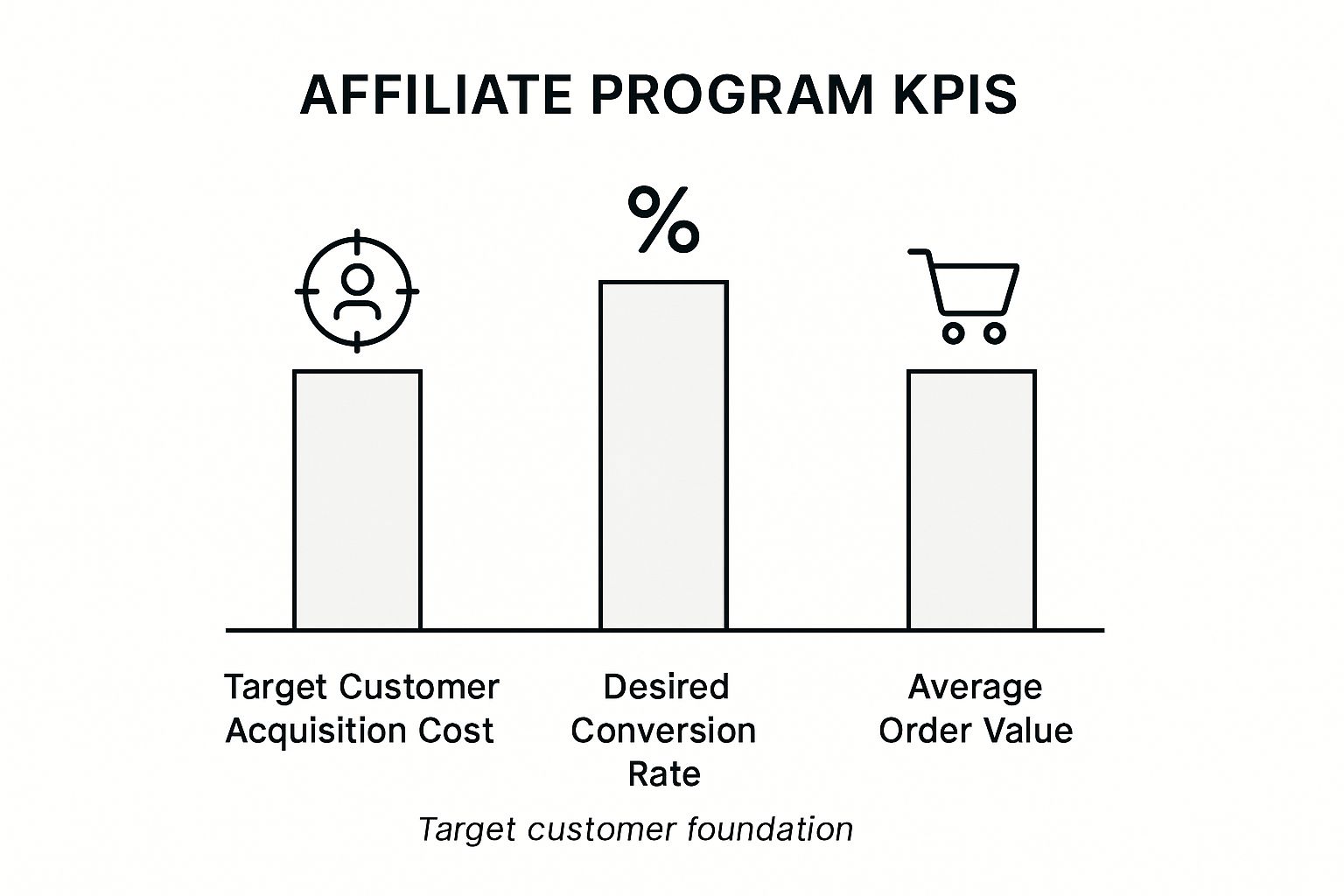So, you're thinking about starting an affiliate program? Smart move. At its core, it’s a performance-based marketing machine where you pay partners—think bloggers, influencers, or even other companies—only when they deliver real results, like a sale or a lead. It's a way to tap into their trusted audiences for powerful, scalable growth.
Why an Affiliate Program Is Your Next Growth Engine

Jumping into affiliate marketing is one of the most strategic ways to build a powerful, performance-based sales channel. Forget traditional advertising where you burn cash on clicks and impressions that might go nowhere. With an affiliate model, your marketing spend is tied directly to tangible outcomes.
You only open your wallet when a partner's referral turns into an actual sale or a qualified lead. This makes it an incredibly efficient way to keep your customer acquisition costs in check.
Plus, you get to tap into a massive network of creators, industry experts, and influencers. These people have already done the hard work of building credibility with audiences that likely match your ideal customer profile. When they recommend your product, it lands as a genuine endorsement, not just another ad. That means warmer, higher-converting traffic coming your way.
The Power of Performance-Based Partnerships
The real beauty of an affiliate program lies in its scalability and predictable costs. As you grow, you can bring on more and more affiliates without gambling with your marketing budget. Every new partner is a new potential revenue stream, all running on a cost-effective, results-driven model.
It creates a win-win relationship. Your partners are motivated to promote you effectively because their income is tied directly to the sales they generate. You’re essentially building a massive, motivated sales team that works purely on commission, opening up new markets and customer segments you might have struggled to reach on your own.
This isn’t just a short-term sales play. It's an investment in sustainable, long-term growth powered by trusted relationships.
An affiliate program transforms your marketing spend from a gamble into a calculated investment. You're no longer just buying ad space; you're building a network of advocates who are financially incentivized to champion your brand's success.
Tapping into a Growing Market
By launching an affiliate program, you're also positioning your brand right in the middle of a booming industry. In the United States alone, spending on affiliate marketing is on track to hit nearly $12 billion in 2025. That's a jump of almost 12% from 2024. You can read more about the rise of affiliate marketing on Wix.com.
This trend makes one thing clear: businesses of all sizes are leaning on performance-based partnerships to drive customer acquisition and sales.
Before we dive into the "how-to," let's quickly break down the essential pillars you'll need to build. Think of these as the non-negotiables for a program that actually works.
Core Components of a Successful Affiliate Program
A quick overview of the key pillars you'll need to establish for a successful affiliate program, which we'll cover in detail.
| Component | Key Objective | Why It Is Critical |
|---|---|---|
| Clear Commission Structure | Define exactly how and when affiliates get paid. | Predictable earnings motivate affiliates and prevent confusion. A clear structure is your best recruiting tool. |
| Reliable Tracking Tech | Ensure every referral and sale is accurately attributed. | Trust is everything. If affiliates don't believe they're getting credit for their sales, they'll leave. |
| Compelling Creative Assets | Provide partners with the tools they need to succeed. | High-quality banners, email templates, and copy make it easy for affiliates to promote your brand effectively. |
| Transparent Affiliate Agreement | Set clear rules, expectations, and terms for everyone. | A solid agreement protects both you and your partners, outlining promotion methods, payout terms, and grounds for termination. |
Getting these four pieces right from the start will save you a world of headaches down the road and set you up for a program that can truly scale.
Building Your Program's Foundation
Before you even think about recruiting your first partner or sending a single outreach email, you have to pour the concrete. Building the internal framework for your affiliate program is that foundation. This isn't just busywork; it's about clearly defining what success actually looks like for your business.
Get this part right, and you'll prevent a world of chaos later on. A solid foundation ensures every bit of effort is aimed at tangible, measurable goals. Without it, you're just guessing.
Defining Your Program's Goals and KPIs
Your affiliate program can't just be a side project floating in a vacuum. It needs to tie directly into your company's bigger picture. The first step is to get specific and define what a successful referral means in cold, hard numbers.
This means setting clear targets for a few core metrics. These KPIs will become your north star, guiding every decision you make from here on out.
Here are the essentials to lock down from day one:
- Target Customer Acquisition Cost (CAC): Your affiliate commissions are a direct line item in your CAC. You need to know the absolute maximum you can afford to pay for a new customer through this channel and still turn a profit.
- Desired Conversion Rate: What percentage of clicks from affiliate links need to turn into paying customers for this program to be a winner? Start with a realistic goal based on your site's current performance. Something in the 2-5% range is a healthy place to begin.
- Average Order Value (AOV): Set a target for the average purchase size you want affiliates to drive. This is crucial for modeling your potential earnings and making sure partners are attracting high-value customers, not just bargain hunters.
These numbers aren't just vanity metrics. They are the benchmarks you'll measure everything against, turning a vague marketing idea into a growth engine you can actually track.
Creating Your Ideal Affiliate Profile
Let’s be clear: not all affiliates are created equal. The success of your entire program hinges on finding and recruiting the right partners for your brand.
Casting a wide net and accepting anyone with a pulse is a classic mistake. It's a recipe for low-quality traffic, brand headaches, and wasted time. A much smarter approach is to create a detailed profile of your ideal affiliate—think of it as a buyer persona, but for your partners.
Ask yourself a few critical questions to get to the heart of who you're looking for:
- Who is their audience? Does their following perfectly match your target customer? A niche blogger with 5,000 hyper-engaged readers is often far more valuable than a general influencer with 100,000 passive followers.
- What kind of content do they create? Are they a YouTuber who specializes in in-depth product reviews? A blogger who writes detailed how-to guides? Or maybe a podcaster with a loyal listenership in your exact industry?
- What's their vibe? Look at their platform's tone and overall quality. Does their brand aesthetic mesh with yours? You're looking for partners who will represent your company authentically and professionally.
Your ideal affiliate might be a power user who already loves your product, or it could be an established industry voice. Defining this profile early makes your recruitment efforts laser-focused and dramatically more effective.
The real goal isn't just to get clicks. It's to partner with creators who can genuinely and persuasively communicate your product's value to an audience that already trusts them. That's the core of authentic, performance-based marketing.
Establishing the Legal Framework
The final piece of your foundation is the legal agreement governing the relationship between you and your affiliates. A comprehensive affiliate agreement is completely non-negotiable. It protects your business, sets crystal-clear expectations, and prevents messy disputes down the road. It can be incredibly helpful to see how others handle this; check out an example of an existing affiliate program to get a feel for common structures.
Your agreement should be written in plain English, not legalese, and be easy for any potential partner to find and understand. It needs to cover a few critical areas to be truly effective.
Key Components of an Affiliate Agreement
| Clause | What It Covers | Why It's Essential |
|---|---|---|
| Commission Terms | The exact percentage or flat fee, payout schedule (e.g., Net 30), and conditions for a valid sale. | Eliminates any confusion about earnings and ensures affiliates know exactly how and when they get paid. |
| Cookie Duration | How long a referral cookie stays active after a click (e.g., 30, 60, or 90 days). | Determines the window in which an affiliate can earn a commission, a key selling point for attracting top partners. |
| Promotional Rules | Defines what's fair game and what's off-limits for marketing (e.g., rules on paid search, coupon usage, etc.). | Protects your brand from being associated with spammy or unethical tactics that could tarnish your reputation. |
| Termination Clause | Outlines the conditions under which you or the affiliate can end the partnership. | Provides a clear exit strategy and gives you recourse if an affiliate breaks the rules. |
With your goals set, your ideal partner profiled, and a solid legal agreement in place, you've officially built a strong foundation. Now, you’re ready to start designing the actual mechanics of your program.
Designing Your Commission Model and Choosing Tech
Alright, you’ve laid the groundwork. Now it's time to get into the nuts and bolts—the two decisions that will truly make or break your affiliate program: how you'll pay your partners and what technology you'll use to run everything.
Getting your commission model right is way more than just picking a percentage out of thin air. It’s a strategic signal to potential affiliates about what you value. The right structure attracts high-quality partners who bring in ideal customers. The wrong one? It can leave you with a flood of low-quality traffic and unmotivated affiliates.
This is also where you have to be realistic about the market. In 2025, affiliate marketing isn't the cheap channel it used to be. Demand is way up, and as more e-commerce businesses jump in, the costs are rising. Success now hinges on building strong, genuine relationships and being smart with your spending, not just recruiting as many affiliates as possible.
Crafting the Right Commission Structure
There's no magic, one-size-fits-all commission structure. The "best" model is the one that fits your business like a glove. Let's look at the most common approaches I've seen work.
- Percentage-Based Commissions: This is the industry standard for a reason. You pay a set percentage of each sale, like 15%. It's perfect for e-commerce because the payout scales with the order value, so your costs are always proportional to your revenue.
- Flat-Fee Commissions: Simple and predictable. You pay a fixed amount—say, $50—for a specific action, like a new paid signup. This is a great fit if you sell a single product or a service with a fixed price, as it makes your budget forecasting incredibly straightforward.
- Recurring Commissions: If you run a subscription business (think SaaS or a membership site), this is your secret weapon. Paying an affiliate a 20% recurring commission for the life of the customer they referred is a massive incentive. It encourages them to find loyal customers who stick around, not just quick signups.
- Tiered Commissions: This is how you light a fire under your top performers. You can set up tiers where an affiliate earns 10% on their first 10 sales, 15% for the next 15, and 20% on anything after that. It gamifies the process and gives your best partners a clear path to earning more.
If you're looking for more inspiration, we've put together a guide with a bunch of real-world scenarios. You can check it out here: different affiliate commission structure examples.
The infographic below really drives home how your Target Customer Acquisition Cost, Desired Conversion Rate, and Average Order Value all tie together. These aren't just numbers on a spreadsheet; they're the financial pillars of your entire program.

Nailing the balance between these three metrics is what creates a commission structure that’s both attractive to partners and sustainable for your business.
Selecting Your Affiliate Management Technology
Once you've figured out the money, you need the engine to run the program. Your affiliate platform is the central hub for everything—tracking clicks, calculating commissions, paying partners, and communicating updates. Don't underestimate this decision.
You've basically got three roads you can go down, and each has its own set of trade-offs. It's smart to get a lay of the land by looking into some of the top affiliate marketing platforms to see what's out there.
Your choice of technology isn't just a technical decision; it's a strategic one. It dictates how much control you have, how much time you'll spend on management, and ultimately, how scalable your program will be.
Choosing the right platform can be tricky, so I've put together a table to help you compare the main options at a glance.
Comparing Affiliate Platform Options
Here’s a breakdown of the three main types of platforms, designed to help you figure out the best fit for your business goals and budget.
| Platform Type | Best For | Key Advantages | Potential Drawbacks |
|---|---|---|---|
| Large Affiliate Networks | Businesses seeking rapid access to a huge pool of existing affiliates. | Instant reach, built-in trust and payment processing, broad discovery potential. | High network fees, less brand control, intense competition for affiliate attention. |
| Self-Hosted Software | Tech-savvy businesses with development resources that want total control. | One-time cost, complete customization, no ongoing network fees. | Requires technical setup and maintenance, no built-in affiliate network, you handle all support. |
| SaaS Platforms (like Refgrow) | Most SaaS and e-commerce businesses looking for a balance of control and ease of use. | Fast setup, user-friendly dashboards, seamless integrations, and predictable monthly costs. | Subscription fees, feature sets can vary widely between platforms. |
After weighing the pros and cons, most businesses just starting out find that a dedicated SaaS platform hits the sweet spot. It spares you the technical headaches of a self-hosted solution but gives you way more control and a more direct relationship with your affiliates than a massive, impersonal network.
For launching, managing, and scaling a program today, it’s the most efficient and effective route to take.
How to Find and Recruit Great Affiliates

Now that you’ve laid the groundwork, the real make-or-break moment for your affiliate program arrives. It all comes down to the quality of the people you partner with. Honestly, a program is only as good as the affiliates promoting your product.
The goal isn't just to get an army of people to share a link. You’re looking to build a curated team of genuine brand champions—people whose audience trusts them implicitly and whose values click with your own. This is where thoughtful, strategic recruitment makes all the difference, separating the programs that thrive from those that just fizzle out.
Start With Your Existing Customer Base
Believe it or not, your best and most powerful affiliates are probably already using your product. Your happiest customers are a goldmine that too many businesses overlook. They already get the value of what you offer and can talk about it with a level of authenticity that’s impossible to fake.
When they recommend your product, it doesn't sound like a canned ad because it isn't. It's a real story from a real user, and that kind of social proof is priceless.
Here’s how to tap into this resource:
- Targeted email campaigns: Don't just blast your whole list. Reach out specifically to long-term customers or those you know are power users. Invite them to an exclusive, customer-only affiliate program to make them feel special.
- In-app notifications: A simple, non-intrusive banner inside your app can catch the eye of your most engaged users. Let them know they can earn by spreading the word.
- A simple sign-up page: Make it dead simple for any customer to find and join your program, maybe right from their account dashboard.
Starting with this warm audience gives your program an immediate boost with partners who are already rooting for you.
Analyze Your Competitors' Affiliates
Want a shortcut to finding proven performers in your niche? Go see who’s already promoting products similar to yours. In a way, your competitors have done some of the initial legwork for you by finding and vetting partners who know how to drive sales in your market.
Just hop on Google and search for things like "[competitor name] review" or "best [your product category]." You’ll quickly find the bloggers, YouTubers, and review sites that are major players in your space.
Once you have a list, do a little digging. Is their content actually good? Do they produce high-quality, in-depth reviews? Is their audience engaged in the comments? If so, you've found a prime candidate. The conversation is much easier because they already speak your industry's language.
Don't just try to poach them; give them a genuinely better offer. That could be a higher commission rate, a longer cookie duration, or access to better marketing assets. Give them a compelling reason to put your product front and center.
Crafting Personalized Outreach That Actually Works
Nothing gets an email deleted faster than a generic, copy-and-pasted template. The high-value affiliates you want to work with get dozens of these pitches every single week. To cut through the noise, your outreach has to be personal, respectful, and focused on the value you bring to them.
Before you even think about hitting "send," do your homework. Read their blog posts, watch their videos, and get a feel for their content style. Your first email should make it obvious you've actually paid attention. For a much deeper dive, our guide on how to recruit affiliates effectively breaks down outreach strategy in even more detail.
Here’s a simple email structure that consistently gets replies:
- Give a specific compliment. Start by mentioning a specific piece of their content you genuinely liked. Something like, "I just read your review of Product X, and your breakdown of the features was incredibly helpful."
- Make a clear connection. Briefly explain why your product is a perfect fit for their audience. Connect it to a problem they've discussed or a topic they cover regularly.
- Present a compelling offer. Be upfront with your commission rate and any unique perks. Transparency shows you respect their time and business.
- End with a simple call to action. Make the next step easy. "Would you be open to a quick 15-minute chat next week?" or "Let me know if you'd like me to set you up with a free account to test it out."
Personalization shows you see them as a potential partner, not just another name on a spreadsheet.
Create a Seamless Onboarding Experience
Getting an affiliate to say "yes" is just the beginning. A clunky, confusing onboarding process can kill their motivation before they even start. A confused affiliate is an inactive affiliate, which helps no one.
Your job is to arm them with everything they need to start succeeding from day one. This should be neatly packaged in a welcome kit or a dedicated resource hub within your affiliate dashboard.
Your onboarding materials must include:
- Brand Assets: Your logos, brand colors, and clear guidelines to keep their promotions consistent and professional.
- Marketing Materials: A ready-to-go library of banners, social media posts, and email swipe copy makes it easy for them to get started.
- Program Guide: A simple, clear document explaining your commission structure, payment schedule, cookie duration, and rules.
- Product Info: Links to your best landing pages, helpful tutorials, and case studies they can reference in their content.
A stellar onboarding experience makes new partners feel confident and supported, which is the foundation of a profitable, long-term relationship.
Managing Your Program for Long-Term Growth

Getting your affiliate program live is a huge milestone, but it's really just the starting line. The true secret to turning your program into a reliable revenue channel lies in what you do next. Consistent, proactive management is what separates the thriving programs from the ones that fizzle out after a few months.
Think of yourself as a coach, not just a manager. Your job is to equip, motivate, and guide your partners toward success. When they win, you win. It's a powerful feedback loop that fuels real, long-term growth.
Cultivate Strong Partner Relationships
Your relationship with your affiliates should never feel purely transactional. From my experience, the best results always come from building genuine partnerships, and that starts with clear, consistent communication. Don't just set them up and disappear; keep your partners in the loop.
A simple monthly newsletter can work wonders here. Use it to share valuable updates that actually help them promote you more effectively.
- Product Updates: Announce new features they can highlight in their content.
- Upcoming Promotions: Give them a heads-up on upcoming sales or discounts so they can plan their campaigns in advance.
- Performance Insights: Share high-level trends or top-performing assets to help everyone optimize their strategies.
This regular contact shows you're invested in their success and keeps your brand top of mind. For a deeper dive into building these kinds of strong relationships, check out our detailed guide on how to effectively manage an affiliate program.
Use Data to Identify and Nurture Talent
Your affiliate platform is so much more than a payment processor—it’s a goldmine of data. Regularly digging into your analytics is crucial for understanding what’s working and, more importantly, who your star players are.
Pay close attention to key metrics like click-through rates, conversion rates, and the total revenue generated by each affiliate. This data will quickly reveal two important groups:
- Your Top Performers: These are the affiliates consistently driving high-quality traffic and sales. Don't be afraid to reward them! A personal thank you, a commission bump, or exclusive access to new features goes a long way in keeping them motivated.
- Your Under-Performers: Look for affiliates who have potential but might be struggling. Maybe their traffic is high, but conversions are low. Reach out personally to offer guidance, share best practices, or point them to marketing assets they might have overlooked. A little support can often turn a struggling partner into a solid contributor.
Your top 10% of affiliates will likely drive 80% of your results. Identifying and nurturing this group is one of the highest-leverage activities you can do as a program manager. It’s all about working smarter, not just harder.
The impact of a well-run program can be massive. For companies that actively cultivate their affiliate strategies, these channels can represent 15% to 20% of their total sales. In fact, affiliate marketing spending shot up from $9.1 billion in 2021 to an estimated $13.62 billion in 2024, a growth rate that’s leaving the broader e-commerce sector in the dust. You can discover more insights about affiliate industry trends and see why this channel is such a key focus for growth-minded companies.
Keep Your Affiliates Motivated
Even your best partners can lose steam without ongoing encouragement. Beyond standard commissions, introducing performance-based incentives can keep your program exciting and drive focused effort when you need it most.
Consider running contests or offering bonuses to inject some energy into the program. These tactics create a sense of friendly competition and give affiliates clear, short-term goals to aim for.
Effective Motivation Tactics
- Sales Contests: Offer a cash prize or a premium product to the affiliate who drives the most sales in a given month.
- Tiered Bonuses: Set performance milestones, like a $100 bonus for every 10 sales an affiliate generates.
- First-Sale Bonus: Motivate new affiliates to get going quickly by offering a small bonus for their very first referred customer.
By actively managing communication, analyzing data, and keeping your partners engaged, you transform your affiliate program from a simple marketing tactic into a dynamic and scalable growth engine for your business.
Even with the best plan in hand, you're bound to have a few nagging questions before jumping into affiliate marketing. It’s smart to get these sorted out before you invest your time and budget. Think of this as your quick-start FAQ, designed to clear up the most common hurdles you'll face.
Let's dig into the big questions that come up time and time again.
How Much Does It Cost to Start an Affiliate Program?
This is usually the first thing people ask, and the honest answer is: it really depends on the path you take. The costs can vary wildly, with your choice of technology being the single biggest factor.
For most businesses, a modern SaaS platform is the sweet spot. You’re looking at monthly fees that can range anywhere from $50 to several hundred dollars, depending on how advanced you need to get. This gives you predictability. Beyond that, your main expense is the commission you pay affiliates—but that’s a good problem to have, since you only pay when they make you money.
Alternatively, you could join a massive, well-known affiliate network. Be prepared for a hefty setup fee, often running into the thousands of dollars, plus they'll take a cut of every commission you pay out. At the other end of the spectrum is a completely self-hosted solution. This means a big upfront investment in development, but your ongoing fees will be lower. It's really only a viable option if you have a dedicated tech team ready to build and maintain it.
How Long Until I See Real Results?
If you’re looking for a flood of sales on day one, you might need to adjust your expectations. Affiliate marketing is a long game, not a quick win. It’s totally normal to see just a few sales trickle in during the first month or two.
You should expect it to take a solid 3 to 6 months to build enough momentum for consistent, meaningful revenue.
Why so long? That initial period is all about laying the groundwork. You’re finding and recruiting the right partners, not just anyone. Those partners then need time to create genuine, high-quality content promoting your product. Finally, that content needs time to get discovered by their audience and start ranking in search engines.
Success isn't about a big launch day splash. It's about the slow, steady build-up from nurturing relationships and optimizing your program over time.
What Is the Best Way to Prevent Affiliate Fraud?
Protecting your program’s integrity from the very beginning is crucial. Things like click fraud or affiliates using shady promotional tactics can bleed your budget and tarnish your brand. The best defense is a good offense.
Start with your recruitment. Manually vet every single affiliate who applies. This is your first and most important line of defense. Don't just auto-approve everyone. Look for partners who have a real, established audience that aligns with your brand.
Your platform’s tech is also a huge piece of the puzzle. A good affiliate management tool should have fraud detection built right in. These systems are designed to automatically flag suspicious patterns, such as:
- A massive spike in clicks with no conversions.
- Traffic coming from strange or low-quality websites.
- A bunch of conversions from the same IP address in a short window.
Finally, your affiliate agreement is your legal backbone. Be crystal clear about what’s not allowed. Spell out the rules on things like bidding on your branded keywords, using email spam, or promoting fake coupon codes. Keep an eye on your data, and if something looks off, dig in. This kind of vigilance keeps your program healthy and profitable.
Ready to launch a fully native, scalable affiliate program without the technical headaches? With Refgrow, you can get started in minutes with just one line of code, creating a seamless experience for your partners and customers. Join over 1,600 businesses and build your growth engine today.

